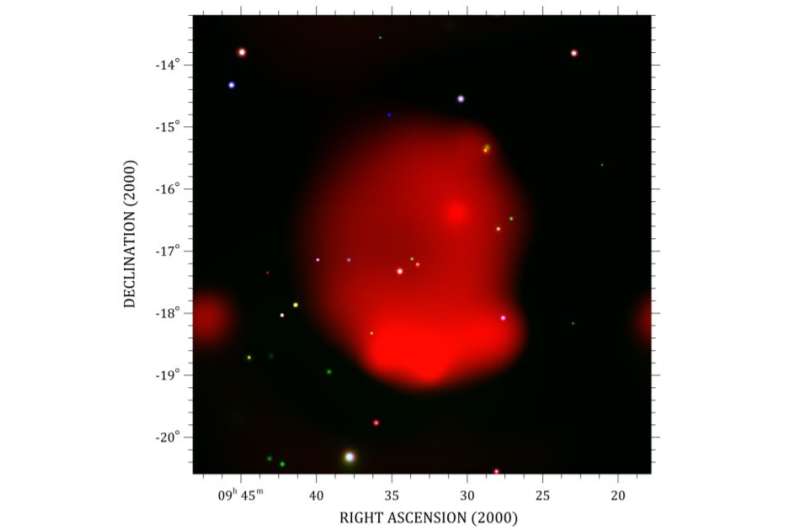March 8, 2021 report
Large supernova remnant detected by eROSITA

Using the extended Röntgen Survey Imaging Telescope Array (eROSITA) instrument onboard the Spektr-RG spacecraft, astronomers have detected in X-rays a new large supernova remnant (SNR). The newfound object, dubbed "Hoinga," turns out to be one of the largest SNR discovered at wavelengths other than radio. The finding is reported in a paper published February 26 on the arXiv pre-print server.
SNRs are diffuse, expanding structures resulting from a supernova explosion. They contain ejected material expanding from the explosion and other interstellar material that has been swept up by the passage of the shockwave from the exploded star.
Studies of supernova remnants are important for astronomers as they play a key role in the evolution of galaxies, dispersing the heavy elements made in the supernova explosion and providing the energy needed for heating up the interstellar medium (ISM). SNRs are also believed to be responsible for the acceleration of galactic cosmic rays.
Researchers assume that our Milky Way galaxy hosts about 1,200 SNRs; however, only 300 of them have been identified so far, mostly by radio surveys. Some projects, like the eROSITA All-Sky Survey (eRASS), can be used to detect new SNRs in X-rays, and recently, a team of astronomers led by Werner Becker of the Max Planck Institute for Extraterrestrial Physics in Garching, Germany, has reported such finding.
"Using data from the first SRG/eROSITA observatory all-sky survey we discovered one of the largest SNRs in the sky," the astronomers wrote in the paper.
The newly found SNR, designated G249.5+24.5, was named Hoinga—it is the medieval name of Becker's hometown Bad Hönningen am Rhein. The observations show that Hoinga has a diameter of about 4◦.4," therefore, it is nearly the largest SNR ever detected at radio wavelengths and comparable in size to the largest detected object of this type, G65.3+5.7.
Hoinga showcases a circular-shaped morphology with a diffuse X-ray emission filling almost the entire remnant. It has a clear shell structure, suggesting that it is a classic shell-type SNR, not centrally powered. The researchers noted that its highly circular nature indicates that it is expanding into a region of relatively uniform density.
Based on the data, the astronomers estimated that Hoinga has a gas temperature of about 0.1 keV and an absorbing column density of some 360 quintillion cm−2. The radio spectral index was found to be at a level of -0.69, and the distance to the remnant was calculated to be most likely 1,600 light years. The age of this SNR is assumed to be between 21,000 and 150,000 years.
"From its size and X-ray and radio spectral properties, we conclude that Hoinga is a middle-aged Vela-like SNR located at a distance of about twice that of the Vela SNR, i.e. at ∼500 pc," the authors of the paper concluded.
More information: Hoinga: A supernova remnant discovered in the SRG/eROSITA All-Sky Survey eRASS1, arXiv:2102.13449 [astro-ph.HE] arxiv.org/abs/2102.13449
© 2021 Science X Network





















